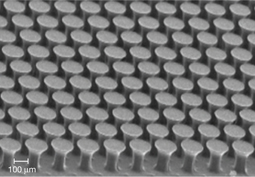Nature has provided engineers with extraordinary templates for materials and devices. Of particular importance for the development of adhesives are a gecko’s feet. Many sticky materials that mimic the gecko have been developed. However, producing those materials requires cleanroom lithographic and etching processes, which have high costs that have prevented the commercialization of such bioinspired adhesive materials. That is, until now.
With support from the National Science Foundation, nanoGriptech, a Carnegie Mellon Univ. spinout, has commercialized a new class of gecko-like dry adhesives. The materials have the high shear, tensile, and peel strengths of conventional pressure-sensitive adhesives, with the added benefits of being residue-free and easy to remove and reuse without loss of performance.
The gecko gets its sticking power from millions of tiny hair-like structures called setae covering the base of its toes. At the end of each of those microscopic hairs are hundreds of nano-sized tips, which establish intimate contact with the surface that the gecko is climbing.
Instead of hairs, the new material consists of arrays of micro- and nano-scale fibers with orderly mushroom-shaped tips. The fiber arrays form molecular-scale bonds with a mating surface through strong van der Waals forces — enabling high adhesion and shear strength. In addition, the fibers’ unique micro-geometry distributes stresses across the fiber tip equally and provides more tip contact area than other gecko-inspired structures described in the literature. The result is stronger and more robust adhesion.
The uniqueness of the gecko-like adhesive comes from the company’s fabrication process. Adapted from processes used in the semiconductor industry, the technique involves traditional cleanroom photolithographic, etching, molding, and contact-printing steps to make a one-off microfiber geometry template. That template can be replicated numerous times under non-cleanroom conditions by conventional inexpensive, automated lamination, or web-based, manufacturing processes that have been slightly modified.
nanoGriptech’s materials can be produced in discrete sheets or continuous rolls. Prototype products include a 2.5-ft2 sheet of fibers of various castable elastomers and a 6-in. roll of dry adhesive tape of the same microfibers made by a continuous process. The company can produce tens of thousands of square feet of adhesive using processes and equipment that can be scaled to meet anticipated demand by customers in the apparel, automotive, consumer electronics, defense, and other industries.
The new material has commercial potential for fasteners and adhesives in a variety of applications. Since the dry adhesive is residue-free and is reusable, it could be used to repeatedly manipulate delicate glass components during manufacturing. It can also increase the friction and gripping ability of surfaces ranging from an equestrian saddle to an amputee’s limb, even in wet and oily conditions.

▲ nanoGriptech’s adhesive consists of arrays of microscopic fibers with mushroom-shaped tips that mimic the hair-like structures covering the surface of the gecko’s feet.
“Our customers love the performance of the nanoGriptech product, with excellent grip to the saddle when they need it without excessive stickiness when they don’t,” says Kevin Maxie, CEO of Struck Apparel, a manufacturer of equestrian riding breeches and an early adopter of the new materials.
nanoGriptech is also targeting the automotive market with its conformable fasteners that integrate leather and upholstery coverings with foam seat pads. Designers of automotive seating are currently limited by hook-and-loop and mushroom fasteners that are costly, have high scrap rates, and are unable to generate ergonomic and aesthetic concave seating surfaces to meet consumer demand for sleek car seat designs that do not buckle or ripple over time. Vehicle manufacturers desire seat covers that can be easily removed if they need to be replaced or if the underlying components need to be repaired. nanoGriptech’s technology solves those problems by providing conformal, robust, and reversible fastening.
The company is currently exploring with customers the use of the gecko-inspired adhesives to create unique, first-to-market designs, and to solve difficult manufacturing challenges. As each new solution comes to market, nanoGriptech will scale up its manufacturing capacity accordingly.
This technology was funded through the NSF Small Business Innovation Research Program.
This article was prepared by the National Science Foundation in partnership with CEP.

Copyright Permissions
Would you like to reuse content from CEP Magazine? It’s easy to request permission to reuse content. Simply click here to connect instantly to licensing services, where you can choose from a list of options regarding how you would like to reuse the desired content and complete the transaction.
